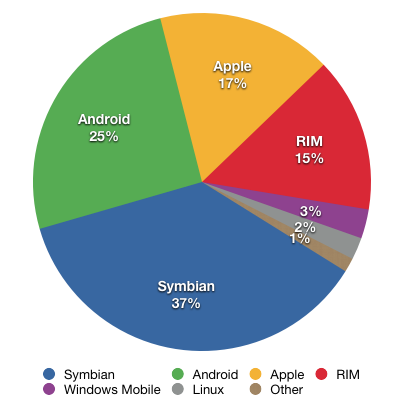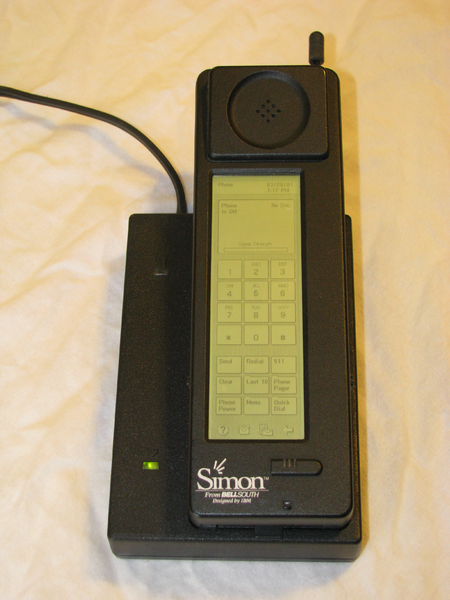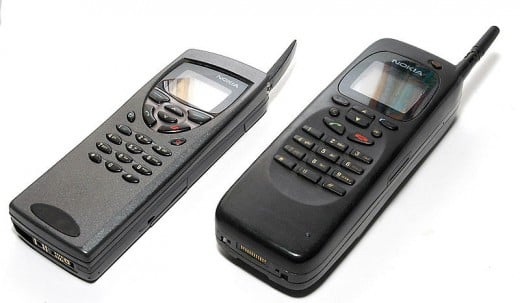Choosing the Right Smart-Phone
A Quick Note
First, I am very hesitant to cover this topic, but a friend, Michael R. asked, so here goes.
Right off the bat I want to explain a few things. I own one smart-phone. This automatically means I know more about that one phone than the others. Despite this fact I'm going to do my best to be impartial. It will be hard though. Additionally, in order to cover this properly, I'm going to try to categorize these phones by possible use. This is going to be tough, because at some point they all do the same things regardless of provider or manufacturer.
Still, to make the article more sensible the divisions will be based on interface, network coverage, and operating system. All of these phones lend themselves to business use as well as personal use.
As always I have not been compensated by any company mentioned in this article in any way.
What is a "Smart-Phone?"
Basically a smart-phone is a computer that runs supplied or added software. It also fits in your hand and happens to make phone calls. That's it in a nutshell.
As a computer it allows you to do all sorts of things you'd normally do with a computer; surf the Internet, send eMail, send photos, do calculations, store addresses and phone number and play games. Additionally, a smart-phone allows you to download and install software to the phone to extend it's capabilities.
Because it's a smart-phone it also allows you to make phone calls and set up and use voicemail.
These last two services now fall firmly into a gray area because any computer with MajicJack or Skype or even Google Phone will allow you to do those things on a computer with an Internet connection...without dedicated phone service.


A Little History
The first "smart-phone" was developed by IBM and sold as the Simon. Simon was a phone that also had a calendar, world clock, note-pad, address book, calculator, e-mail, some games and could send and receive faxes. It was first sold in 1992 by Bell-South. Naturally the Simon ran on a "home-grown" operating system from IBM.
Nokia followed this trend with the 9000 communicator series. The 9000 communicator could Fax, send messages, email, send wireless images, had a connection for digital cameras, sent text via Internet, a web terminal for surfing, a contacts list, notes, calendar, calculator; world time clock, and a message composer. It ran on the GEOS (by Geoworks) operating system.
The Nokia Communicator Series was introduced in 1996.
The Next Generation
By 2002 the playing field for smart-phones increased dramatically. There were at least four phone operating systems and an even larger number of hardware manufacturers creating phones.
The operating systems included Symbian, Windows CE, Palm OS, and Research in Motion (RIM) OS.
The phones were made by companies Ericsson, Microsoft, Palm (Handspring), RIM, and Nokia.
See the table below for the manufacturer and operating system.
Country of Origin
| Manufacturer
| Operating System
|
|---|---|---|
Sweden
| Ericsson
| Symbian
|
United States
| Microsoft
| Windows CE
|
United States
| Palm/Handspring
| Palm OS
|
Canada
| Research in Motion (RIM)
| RIM OS
|
Finland
| Nokia
| Symbian
|
South Korea
| Samsung
| Android
|

Third Generation (sort of)
3G is bandied about as a term almost universally. I'm not sure why because the designation actually means "third generation," which is not that much harder to say than "3G."
Generally though 3G means the phone can upload and download data to/from the cellular network at about two million bits per second. (2mbps)
Three "G" isn't just about the technology in the phone (hardware), but includes the functionally of the operating system (software) and the cell-networks (coverage) these phones use to accomplish their functions.
It can be very confusing and that's an understatement.
For all of that almost every phone made in this generation does exactly the same things as every other smart-phone. The big distinctions became the actual coverage of the cell-network and the operating systems in the phones themselves. The finer point of these Operating Systems being the interface between the phone and its user.
Tipping Point in Smart-Phones
Starting in 2007 this generation saw the introduction of the iPhone which uses the Apple OSX operating system. This year also saw the introduction of the Android operating system, which is strongly supported by Google and a consortium of smart-phone makers. This consortium, called the Open Handset Alliance, includes Google, HTC (Harris Technology Corporation), Dell, Intel, Motorola, Qualcomm, Texas Instruments, Samsung, LG, T-Mobile, Nvidia, and Wind River Systems.
This is a tipping-point, in the authors opinion, because smart-phone sales (and the associated networks, interfaces, and contracts) increased geometrically.
User Interfaces
Since all smart-phones in this generation now include a color graphical user interface (also called an Operating System [OS]), the biggest distinction, in the phones themselves, is how the phone user is allowed to interact with the phone.
The two primary interfaces are either a track-ball/touchpad and keyboard combination or a touchscreen where the pointing device and keyboard are the surface of the phone screen and the user's finger. But there are also phones out there with a touchscreen & keyboard.
Forth Generation
This is what 4G actually means. At this point in time there are only three players on the 4G scene. They are Sprint, T-Mobile, and Verizon. All three have upload/download speeds in the hundreds of millions of bits per second.
What that means, of course, is that downloading a picture, song, text message, etc. will be that much faster.
Coverage
Sprint and T-Mobile still have the most complete coverage across the United States with Sprint being the only one of the two that has 4G support in Hawaii. Verizon still lags behind in coverage, but that will likely change in the next two years.
Which is the Best Phone?
Great question.
I wish I could give a simple answer. There are four major factors here. The cell network, the operating system, the provider, and the phone itself.
Maybe the better question is 'what are you going to use the phone for?'
The Cell Network
I've already talked about coverage above. Sprint has the best (so far), followed closely by T-Mobile, followed by Verizon then everyone else.
Some pre-paid phones have contracts with more than one provider thus getting excellent coverage nearly anywhere, but I'll save the "pre-paid" phones for another hub.
Sprint uses what it calls Mobile-WiMax. This cellular technology is propriatary so there's not much I can say about it, but it does support upload speeds of fifty-six (56) mega-bits per second (mbps) and download speeds of one hundred twenty-eight (128) mbps.
T-Mobile uses what it calls High Speed Packet Access (HSPA ). Again this is proprietary, but it improves on Sprint's system primarily by reducing latency and lag time. This attempts to make up for the upload speed of twenty-two (22) mbps and the download speed of fifty-six (56) mbps.
Verizon uses what it calls Long Term Evolutions (LTE) which is also proprietary. LTE supports upload speeds of fifty (50) mbps and download speed of one-hundred (100) mbps; roughly on par with Sprint.
Operating System
Microsoft has Windows CE and now Windows 7. Android is public domain and has a lot (A LOT) of developers. Apple has OS-X (Snow Leopard) and Symbian has a strong following too.
All of these operating systems offer phone, text (SMS & MMS), web-access, email access, and the plethora of other applications mentioned at the beginning of this article.
From the table below you can see which phones (or manufacturers) offer which operating systems.
They all do roughly the same things including the ability to add new programs to your phone. Apple through it's application store and the others through a very wide variety of avenues. Yet another topic for another hub.
Interface and Operating System
Phone (Company)
| Interface
| OS
|
|---|---|---|
iPhone (Apple)
| Touchscreen
| Apple OSX (SnowLeapord)
|
Blackberry (RIM)*
| Trackball / keyboard
| RIM OS
|
Harris Technology Corporation (HTC)
| Touchscreen/keyboard
| Android
|
Nokia (Nokia)
| Touchscreen/one button
| Symbian ^3
|
Nexus One (Google)
| Touchscreen & buttons
| Android
|
Samsung (Samsung)
| Touchscreen & Buttons
| Android
|
The Phone
Apple provide the iPhone 3 & 4 which have the multi-touch interface that is likely one of the best user interface to ever come about. iPhone 3 & 4 have no keyboard, providing instead a QWERTY style virtual keyboard on the touch sreen.
Blackberry uses a more Window-like interface that is based on a track-ball (mouse) and buttons. Later versions of the Blackberry offer both the track-ball and a touchscreen. But to date, all Blackberry phones have a real keyboard.
HTC builds an iPhone analog that has a few more buttons, but is basically a touch screen phone with a multi-touch interface. HTC's main advantage is the public domain operating system called Android.
Nokia is also copying the iPhone formfactor and interface.
Nexus (HTC really) is yet another touch-screen as well as the latest Samsungs.
Really the biggest differences are the operating systems.
The Contract
The phones themselves are way more expensive than what the service providers sell them for. For example Samsung is selling its Nexus S for $199.00, but if you buy it unlocked it will cost you $529.00.
The $529.00 is likely close to the actual cost plus a little extra for profit.
So the contract is typically an obligation of two years in which you agree to use a specific plan and also agree to pay a $200 fee if you break the contract. This is the minimum you can expect for the latest and greatest phone unless you plan to pay close to $600 (or more) for it.
Like any contract for anything they are long, hard to read, and loaded with fine print.
Coda
So Michael and whoever else reads this, my apologies. This is long complicated and convoluted, but this is the nature of the smart-phone business at this point in time.
My best advice is ask someone you respect what they are using and why.
Disclaimer
The author was not compensated in any way by any of the companies mentioned in this article.
The author will make a small profit from writing the article itself and a small percentage for any advertising associated with it. The author has no control over the advertising or the contents of those ads.










